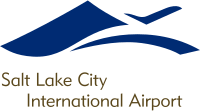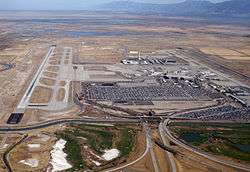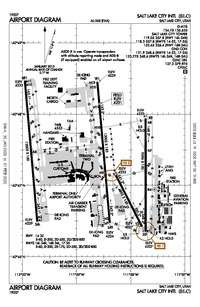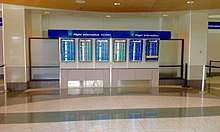Salt Lake City International Airport
Salt Lake City International Airport (IATA: SLC, ICAO: KSLC, FAA LID: SLC) is a civil-military airport located about 4 miles (6.4 km) west of Downtown Salt Lake City, Utah in the United States. The airport is the closest commercial airport for more than 2.5 million people[2] and is within a 30-minute drive of nearly 1.3 million jobs.[3] The airport serves as a hub for Delta Air Lines and is a major gateway to the Intermountain West. The airport sees 343 scheduled nonstop airline departures per day to 93 cities in North America and Europe.[4]
Salt Lake City International Airport | |||||||||||||||||||||||
|---|---|---|---|---|---|---|---|---|---|---|---|---|---|---|---|---|---|---|---|---|---|---|---|
 | |||||||||||||||||||||||
 Salt Lake City International Airport in 2010 | |||||||||||||||||||||||
| Summary | |||||||||||||||||||||||
| Airport type | Public | ||||||||||||||||||||||
| Owner | City of Salt Lake City | ||||||||||||||||||||||
| Operator | Salt Lake City Department of Airports | ||||||||||||||||||||||
| Serves | Salt Lake City, Wasatch Front / Salt Lake City metropolitan area, Northern Utah, Southwestern Wyoming and Southeastern Idaho | ||||||||||||||||||||||
| Location | Salt Lake City, Utah, U.S. | ||||||||||||||||||||||
| Hub for | Delta Air Lines | ||||||||||||||||||||||
| Elevation AMSL | 4,227 ft / 1,288 m | ||||||||||||||||||||||
| Coordinates | 40°47′18″N 111°58′40″W | ||||||||||||||||||||||
| Website | slcairport.com | ||||||||||||||||||||||
| Maps | |||||||||||||||||||||||
 FAA airport diagram | |||||||||||||||||||||||
 SLC Location of airport in Utah / United States  SLC SLC (the United States) | |||||||||||||||||||||||
| Runways | |||||||||||||||||||||||
| |||||||||||||||||||||||
| Helipads | |||||||||||||||||||||||
| |||||||||||||||||||||||
| Statistics (2019) | |||||||||||||||||||||||
| |||||||||||||||||||||||
Source: Salt Lake City International Airport[1] | |||||||||||||||||||||||
Salt Lake City International Airport continues to rank high for on-time departures/arrivals and fewest flight cancellations among major US airports. The airport ranked first for on time departures and arrivals and first for percentage of cancellations as of April 2017.[5] The airport is owned by the City of Salt Lake City and is administered by the Salt Lake City Department of Airports.[6]
History
In 1911, a site for an air field was chosen on Basque Flats, named for Spanish-French sheep herders who worked the fields in the then-desolate area of the Salt Lake Valley, where a cinder-covered landing was subsequently created. The Great International Aviation Carnival was held the same year and brought aviation pioneers representing Curtiss Aeroplane and Motor Company and a team representing the Wright Brothers to Salt Lake City. World-famous aviator Glenn H. Curtiss brought his newly invented Seaplane to the carnival, a type of airplane that had never been demonstrated to the public. Curtiss took off from the nearby Great Salt Lake, awing the 20,000 spectators and making international headlines.[7]
For several years, the new field was used mainly for training and aerobatic flights. That would change in 1920 when the United States Postal Service (USPS) began air mail service to Salt Lake City. The airport expanded and hangars and other buildings began to appear. In the same year, the airfield was given the name Woodward Field, named for John P. Woodward, a local aviator.[8]
In 1925, the postal service began awarding contracts to private companies. Western Air Express, the first private company to carry U.S. mail, began flying from Salt Lake City to Los Angeles via Las Vegas. Less than a year later Western Air Express would begin flying passengers along the same route. Western Air Express later became Western Airlines, which had a large hub in Salt Lake City.[8]
Charles Lindbergh visited Woodward Field in 1927, drawing many spectators to see The Spirit of St. Louis. During the next few years the airport would gain another runway and would span over 400 acres (1.6 km2). In 1930 the airport was renamed Salt Lake City Municipal Airport.[9]
The first terminal and airport administration building was built in 1933 at a cost of $52,000. By then, United Airlines had begun serving Salt Lake City on flights between New York City and San Francisco.[9][10]

As air travel became more popular and the United States Army Air Forces established a base at the airport during World War II, a third runway was added (Runway diagram for 1955). The April 1957 OAG (formerly the Official Airline Guide) shows 42 weekday departures: 18 on Western, 17 United and 7 Frontier. United had flown nonstop to Chicago since 1950, but a New York nonstop didn't start until 1968. The first jets were United 720s in September 1960.
A new terminal was needed and work began on the west side of the airport on Terminal 1, designed by Brazier Montmorency Hayes & Talbot and dedicated in 1960 after seven years of work and a cost of $8 million.[11] In 1968 the airport became Salt Lake City International Airport[12] when a non-stop route to Calgary, Canada was awarded to Western Airlines.
After airline deregulation in 1978, hub airports appeared. Western Airlines, with ties to Salt Lake City since its inception, chose the airport as one of its hubs. Terminal 2 was designed by Montmorency Hayes & Talbot and built solely for Western and had several murals by artist LeConte Stewart.[13]
During the 1980s the airport saw further expansion to both terminals as well as runway extension. In 1987 Western Airlines merged with Delta Air Lines. Salt Lake City would continue to be a major airline hub.
In 1991 the airport opened a new short-term parking garage. The airport opened a new runway in 1995 along with the International Terminal and E concourse for SkyWest Airlines, which was designed by Gensler.[14] A new 328-foot-tall (100 m) control tower, new approach control facility, and a new fire station were opened in 1999.[9]
In 2001, Concourse E was expanded for additional gates and SkyWest Airlines opened its new maintenance hangar and training facility. In 2002, the airport saw heavy crowds as Salt Lake City welcomed over one million visitors for the Winter Olympics.
Recently the airport has upgraded its access roads and parking facilities in preparation for a new terminal. The airport has made minor upgrades to the terminals and concourses including expansion of baggage claim facilities.[15]
In June 2008, Delta Air Lines began daily nonstop service to Paris–Charles de Gaulle. This marked the first scheduled transatlantic route from Salt Lake City. In November 2008, Delta announced nonstop service to Narita International Airport near Tokyo, Japan, mostly as a result of Delta's merger with Northwest Airlines. The service began on June 3, 2009,[16] the first nonstop from Salt Lake City to Asia. Between 2010 and 2011, the flights to Tokyo were seasonal, May to October.[17] Delta has not operated the flight since October 2011.
Three days after the Paris terror attacks, an Air France A380 traveling from Los Angeles, California to Paris, France was diverted to Salt Lake City International Airport due to a bomb threat on the aircraft.[18] The aircraft was the largest plane to ever land at the airport. The airport workers had only 15 minutes to get ready for the emergency landing.[19]
On May 5, 2016, KLM began new, twice weekly nonstop service from Salt Lake City to Amsterdam, and increased service to three times weekly on July 4, 2016. It is the first transatlantic route from Salt Lake City served by a European-based airline. The service is intended to supplement the existing daily flight between Salt Lake City and Amsterdam operated by Air France KLM's Transatlantic Joint Venture partner Delta Air Lines.[20]
Future
The airport is in the middle of constructing a new single terminal and two linear concourses with 78 gates.[21] When completed, SLC will have a similar layout to fellow Delta hubs in Atlanta and Detroit. The two concourses will be connected by two underground tunnels with moving walkways, with the central tunnel leaving room for an APM to be installed in the future when a third concourse is needed.[22] To minimize impacts on airport operations, the terminal is being constructed in two phases. Phase 1 is scheduled to open in September 2020, while Phase 2 will open in 2024.[23]
Facilities
The airport covers 7,700 acres (3,116 ha) and has four runways.[24] The runways are generally oriented in a NNW/SSE magnetic direction due to consistent prevailing winds in this direction.
Terminals

Three passenger terminals have five concourses with a total of 83 gates:
- Terminal 1 has Concourse G (formerly Concourse A) and Concourse F (formerly Concourse B).
- Terminal 2 has Concourse C.
- International Terminal has Concourse D and Concourse E.[25] Arriving international flights only use gates D2, D4, and D6 in Concourse D, however.
Ground transportation

The airport is accessible from I-80 at exit 115 B or from I-215 at exits 22 and 22 B. The airport can also be accessed from North Temple street and Utah State Route 154 (Bangerter Highway) both of which terminate and merge into the airport's Terminal Drive.

Rail and bus services that connect the surrounding region to Salt Lake City International Airport include TRAX light rail service from the Airport station, UTA bus service, and FrontRunner commuter rail (via TRAX).
Ground transportation is available to ski resorts and locations throughout Salt Lake, Davis, Weber, Utah and Summit counties from Salt Lake International Airport. Many Salt Lake taxis, limousines and shuttles accommodate ski equipment.
Cargo operations
The airport handled 156,319 metric tonnes of cargo in 2008.[26]
General aviation
Despite being the 28th busiest airport in the world in terms of aircraft operations,[27] the airport still maintains a large general aviation presence. In 2008, 19% of aircraft movements at the airport came from general aviation traffic.[26] This is in contrast to most large airports, which encourage general aviation aircraft to use smaller or less busy airports in order to prevent delays to commercial traffic. The airport is able to effectively handle both commercial and general aviation traffic largely in part to the airport's layout and airspace structure. Nearly all general aviation operations are conducted on the east side of the airport, away from commercial traffic. Additionally, smaller and relatively slower general aviation aircraft arrive and depart the airport in ways that generally do not hinder the normal flow of arriving or departing commercial aircraft.
2007 data shows there are 388 general aviation aircraft based at the airport.[24] The airport has two fixed-base operators, TAC Air and Atlantic Aviation, located on the east side of the airport. The airport has facilities for air ambulance, law enforcement, as well as state and federal government aircraft. Additionally, the airport is home to several flight training facilities, including one operated by Westminster College.
Military operations
The Utah Air National Guard operates what was previously named the Salt Lake City Air National Guard Base on the east side of the airport. In November 2014, the installation was renamed the Roland R. Wright Air National Guard Base after Brigadier General Roland R. Wright, USAF (Ret).[28]
The base occupies approximately 135 acres as a U.S. Government cantonment area leased from the airport. In addition to flight line, the installation comprises 63 buildings: 3 services, 13 administrative and 47 industrial. There are 255 full-time Air Reserve Technician and Active Guard and Reserve personnel assigned, augmented by 1,343 part-time traditional air national guardsmen. The host wing for the installation is the 151st Air Refueling Wing (151 ARW), an Air Mobility Command (AMC)-gained unit operating the KC-135R Stratotanker.
Airlines and destinations
Passenger
Cargo
| Airlines | Destinations |
|---|---|
| Alpine Air Express | Boise, Cedar City, Idaho Falls, Jackson Hole, Pocatello, Rexburg, Rock Springs, St. George (UT), Sun Valley, Twin Falls |
| Ameriflight | Billings, Boise, Elko, Ely, Jackson Hole, Price, Rexburg, Rock Springs, Vernal, Winnemucca |
| DHL Aviation | Cincinnati, Sacramento–Mather |
| FedEx Express | Boise, Indianapolis, El Paso, Kansas City, Memphis, Oakland, Ontario |
| FedEx Feeder | Idaho Falls, Pocatello, Sun Valley, Twin Falls |
| UPS Airlines | Boise, Chicago–Rockford, Denver, Kansas City, Louisville, Oakland, Ontario |
| Western Air Express | Boise, Denver–Centennial |
Statistics
Top destinations
| Rank | Airport | 2017 Passengers | Carriers |
|---|---|---|---|
| 1 | Denver, Colorado | 726,000 | Delta, Frontier, Southwest, United |
| 2 | Los Angeles, California | 621,000 | Alaska, American, Delta, Southwest, United |
| 3 | Atlanta, Georgia | 570,000 | Delta, Frontier |
| 4 | Phoenix–Sky Harbor, Arizona | 562,000 | American, Delta, Southwest |
| 5 | Seattle/Tacoma, Washington | 535,000 | Alaska, Delta |
| 6 | Las Vegas, Nevada | 459,000 | Delta, Frontier, Southwest |
| 7 | Dallas/Fort Worth, Texas | 445,000 | American, Delta |
| 8 | New York–JFK, New York | 353,000 | Delta, JetBlue |
| 9 | San Diego, California | 346,000 | Alaska, Delta, Southwest |
| 10 | Portland, Oregon | 337,000 | Alaska, Delta |
| Rank | Airport | 2018 Passengers | Carriers |
|---|---|---|---|
| 1 | Amsterdam, Netherlands | 174,503 | Delta, KLM |
| 2 | Paris–Charles de Gaulle, France | 123,342 | Delta |
| 3 | Toronto–Pearson, Canada | 99,208 | Delta |
| 4 | Vancouver, Canada | 94,873 | Delta |
| 5 | Cancún, Mexico | 89,210 | Delta |
| 6 | Mexico City, Mexico | 88,206 | Delta |
| 7 | London–Heathrow, United Kingdom | 69,491 | Delta |
| 8 | Calgary, Canada | 66,459 | Delta |
| 9 | Guadalajara, Mexico | 56,520 | Aeromexico Connect |
| 10 | San José del Cabo, Mexico | 55,940 | Delta |
Airline market share
| Rank | Carrier | Enplanements | Share |
|---|---|---|---|
| 1 | Delta Air Lines | 12,069,000 | 51.18% |
| 2 | SkyWest Airlines | 4,722,000 | 20.03% |
| 3 | Southwest Airlines | 2,506,000 | 10.63% |
| 4 | American Airlines | 1,164,000 | 4.94% |
| 5 | JetBlue Airways | 699,000 | 2.97% |
Accidents and incidents
Accident history for SLC at Aviation Safety Network
- On May 1, 1942, United Airlines Trip 4, a Douglas DC-3 impacted the side of a hill after deviating off course 3.8 miles (6.1 km) NE of Salt Lake Municipal Airport, all 17 on board were killed.[45]
- On January 17, 1963, a West Coast Airlines Fairchild F-27 on a training flight out and back to SLC crashed west of the airport into Great Salt Lake simulating an emergency descent, all three occupants perished.[46]
- On November 11, 1965, United Airlines Flight 227, operated with a Boeing 727, crashed just short of the runway at Salt Lake City International Airport (then named Salt Lake City Municipal Airport), killing 43 of the 91 people on board.
- On December 16, 1969, an Aero Commander 1121 Jet Commander operated by American Smelting and Refining Co. lifted off prematurely, stalled and crashed. Both occupants died.[47]
- On December 17, 1977, United Airlines Flight 2860, a cargo flight operated with a Douglas DC-8 crashed into a mountain near Kaysville while in a holding pattern prior to landing at Salt Lake City International Airport. The crew was trying to figure out an electrical problem and did not realize they were adjacent to a mountain. All three people on board were killed in the accident.
- On January 15, 1987, Skywest Airlines Flight 1834, a Fairchild Metro, collided with a Mooney M20 at 7000 feet while the Metro was on a runway 34 approach. Both aircraft fell and crashed to the ground. All eight on the Metro and two on the Mooney were killed.[48]
- On October 14, 1989, Delta Air Lines Flight 1554, operated with a Boeing 727, caught fire during the boarding process for a flight to Edmonton, Alberta, Canada while the aircraft was parked at a gate. Of the 23 people who were on the aircraft at the time, five sustained minor injuries. While all passengers and crew evacuated, the aircraft was destroyed. An investigation determined the fire started due to a malfunction with the passenger oxygen system.[49]
- On March 2, 1997, a Beechcraft Super King Air operated by Coast Hotels and Casinos impacted terrain 1.5 miles (2.4 km) south of SLC. One passenger out of the four onboard died.[50]
- On November 17, 2015, an Air France Airbus A380 (recognized as Flight 65) en route from Los Angeles to Paris made an emergency landing at Salt Lake City International Airport due to a terror threat, only four days after the November 2015 Paris attacks in Paris, France.[51]
- On March 18, 2020, a magnitude 5.7 earthquake around 3 miles away damaged water lines, grounded all flights, and evacuated all personnel, effectively closing the airport.[52] It reopened 7 hours later.[53]
See also
References
![]()
- "Stats summary" (PDF). slcairport.com. 2018. Archived (PDF) from the original on February 2, 2019. Retrieved February 1, 2019.
- 2006 population estimates from the U.S. Census Bureau Archived December 27, 1996, at the Wayback Machine Retrieved on March 5, 2008.
- "Utah Continuous Airport System Plan – Executive Summary". Utah Department of Transportation. Archived from the original on October 4, 2013. Retrieved September 30, 2013.
- "SLC Fast Facts". Salt Lake City Department of Airports. Archived from the original on October 30, 2015. Retrieved February 2, 2018.
- "Salt Lake City, UT: Salt Lake City International (SLC)". Bureau of Transportation Statistics, United States Department of Transportation. Archived from the original on May 9, 2012. Retrieved January 24, 2011.
- "Department of Airports 2008–2009 budget" (PDF). Salt Lake City Corporation. Archived from the original (PDF) on June 9, 2011.
- "Curtiss Flies at Salt Lake". The New York Times. New York City. April 9, 1911. Archived from the original on November 11, 2012. Retrieved March 4, 2008.
- Wadley, Carma (December 4, 2003). "100 years of Flight". Deseret News. Salt Lake City: Deseret Digital Media. Archived from the original on January 4, 2005. Retrieved March 4, 2008.
- "Airport History". Salt Lake City Department of Airports. Archived from the original on April 13, 2013. Retrieved April 16, 2013.
- Berryman, Marvin E. "A History of United Airlines". The United Airlines Historical Foundation. Archived from the original on September 3, 2013. Retrieved April 16, 2013.
- "J. Willard Marriott Digital Library". content.lib.utah.edu. Archived from the original on December 11, 2012. Retrieved October 24, 2019.
- "Airport History". Salt Lake City International Airport. Archived from the original on February 2, 2014. Retrieved January 29, 2014.
- Mullins, Robert D.; Costanzo, Joe (August 12, 1977). "SL Airport Growing But How?". Deseret News. Retrieved June 16, 2012.
- "Salt Lake City International Airport Commuter Terminal and International Arrivals Building". GPA ARCHITECTS, INC. Archived from the original on October 4, 2013. Retrieved September 30, 2013.
- "Walking path opens at Salt Lake airport". USA Today. The Associated Press. September 4, 2009. Archived from the original on October 4, 2013. Retrieved April 16, 2013.
- Hancock, Laura (June 4, 2009). "Delta begins nonstop flights between Tokyo, Salt Lake". Deseret News. Salt Lake City: Deseret Digital Media. Archived from the original on October 4, 2013. Retrieved April 16, 2013.
- Beebe, Paul (May 7, 2010). "Delta to resume SLC-to-Tokyo route". The Salt Lake Tribune. Salt Lake City: MediaNews Group. Archived from the original on October 4, 2013. Retrieved April 16, 2013.
- Alberty, Erin (November 18, 2015). "Air France plane diverted to SLC after bomb threat is cleared to leave for Paris". The Salt Lake Tribune. Archived from the original on June 25, 2016. Retrieved May 27, 2016.
- "Archived copy". Archived from the original on August 9, 2018. Retrieved August 9, 2018.CS1 maint: archived copy as title (link)
- "KLM to launch service to Salt Lake City (USA) and Ibiza (Spain)". December 15, 2015. Archived from the original on December 22, 2015. Retrieved December 15, 2015.
- "The New SLC". Retrieved February 8, 2020.
- "The New SLC Project Fact Sheet". Retrieved February 8, 2020.
- "New $3.6B Salt Lake City airport opens in 1 year". Retrieved February 8, 2020.
- FAA Airport Master Record for SLC (Form 5010 PDF), effective February 24, 2009
- Salt Lake City International Airport. "SLCA-Overview" (PDF). Archived from the original (PDF) on February 13, 2015. Retrieved April 23, 2015.
- "2008 Salt Lake City International Airport Statistics" (PDF). Salt Lake City Department of Airports. Archived from the original (PDF) on March 4, 2009. Retrieved February 24, 2009.
- World's busiest airports by traffic movements
- "Utah Air National Guard Base renamed to honor 95-year-old hometown hero". Archived from the original on January 5, 2015. Retrieved January 21, 2015.
- "TImetables". Aeroméxico. Archived from the original on November 19, 2018. Retrieved April 8, 2018.
- "Flight Timetable". Archived from the original on February 2, 2017. Retrieved January 29, 2017.
- "Flight schedules and notifications". Retrieved January 7, 2017.
- "Delta resumes Salt Lake City – Memphis service from July 2020". Routes Online. December 2019. Retrieved January 6, 2020.
- "Delta bolsters Miami network to support industry-leading partnership with LATAM". Delta News Hub.
- "FLIGHT SCHEDULES". Archived from the original on June 21, 2015. Retrieved January 7, 2017.
- https://www.sacbee.com/news/coronavirus/article242616286.html
- https://www.businessinsider.com/delta-will-stop-flying-to-11-us-cities-list-2020-6
- "Frontier". Archived from the original on September 12, 2017. Retrieved January 7, 2017.
- "JetBlue Airlines Timetable". Archived from the original on July 13, 2013. Retrieved January 29, 2017.
- "View the Timetable". Archived from the original on February 27, 2017. Retrieved February 26, 2017.
- "Check Flight Schedules". Archived from the original on February 2, 2017. Retrieved January 7, 2017.
- "Timetable". Archived from the original on January 28, 2017. Retrieved January 7, 2017.
- "Salt Lake City, UT: Salt Lake City International (SLC)". Bureau of Transportation Statistics, United States Department of Transportation. Retrieved June 26, 2020.
- "U.S. International Passenger & Freight Statistics – CY 2016 Passengers". United States Department of Transportation. Archived from the original on June 29, 2018. Retrieved August 22, 2019.
- U.S. Department of Transportation, Bureau of Transportation Statistics Archived October 12, 2008, at the Wayback Machine. Accessed January 9, 2017.
- Accident description for NC18146 at the Aviation Safety Network
- Accident description for N2703 at the Aviation Safety Network
- Accident description for N403M at the Aviation Safety Network
- Accident description for N163SW at the Aviation Safety Network
- Archived October 17, 2015, at the Wayback Machine NTSB report
- Accident description for N117WM at the Aviation Safety Network
- Marsh, Rene; Yan, Holly. "2 Air France flights from U.S. to Paris diverted because of bomb threats". CNN. Archived from the original on November 18, 2015. Retrieved November 18, 2015.
- Press, The Associated. "BREAKING: 5.7 earthquake hits Utah". ajc. Retrieved March 18, 2020.
- "Salt Lake airport reopens hours after 5.7 magnitude earthquake". KSLNewsRadio. March 18, 2020. Retrieved April 4, 2020.
External links
![]()
- Official website
- FAA Airport Diagram (PDF), effective June 18, 2020
- FAA Terminal Procedures for SLC, effective June 18, 2020
- Resources for this airport:
- AirNav airport information for KSLC
- ASN accident history for SLC
- FlightAware airport information and live flight tracker
- NOAA/NWS weather observations: current, past three days
- SkyVector aeronautical chart for KSLC
- FAA current SLC delay information